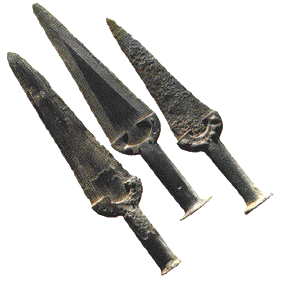
Textbook Unit 2: Leicestershire Before the Romans (300,000BC to AD43)
Page 1 of 2 (p2)
- Palaeolithic Period (Old Stone Age): 300,000 - 9,500 BC
- Mesolithic Period (Middle Stone Age): 9,500 - 4,500 BC
- Neolithic (New Stone Age): 4,500 - 2,000 BC
During these time periods, the only materials used by man for making tools were those which occurred naturally, such as Stone, Wood, Bone, etc.
Of course, at this time, the animals they would have been hunting would be quite different from the animals around today. They would have hunted Elephants, Rhinoceros, deer and wild boar.
The occupation of the area continued periodically between ice ages, which changed the landscape and climate of the area, until around 12,000 years ago, when the last glaciers retreated, leaving a landscape similar to that of today. Since this time, people have always occupied the area.
After the end of the Palaeolithic period, the hunter gatherer people continued for around 5000 years, into the Mesolithic period, which lasted until 4,500BC
It was during this period that the first farmers began to work the land, which led to the construction of small communities. Towards the end of the Mesolithic period and into the Neolithic period, trade started to develop. Trade routs started to spring up across the countryside, several of which crossed the river soar at the places now known as Leicester, and Cotes (just outside Loughborough)
During the Neolithic period, which ran from 4500 BC to 7000BC, farming was developing, as farmers came up with better and more efficient farming methods and tools. The climate was, by this time, similar to that of today, and much of the county was covered by dense oak forest, large areas of which had to be cleared to provide farming land, which required the use of stone axes, examples of which have been found in the area, and which were mainly made of stone from the Charnwood forest.
As trade increased, settlements began to spring up along the trade routes. The largest of these was Leicester, on the main crossing point of the river Soar, where several trade routes all met. The land here was cleared around 4,000 years ago (2000 BC) and the settlement became a major trading post.
The woodland was cleared during this period over much of the Wolds and the Soar Valley, but the higher hills remained untouched, the area now known as Charnwood forest.
QUESTIONS
1. Using the map, describe the distribution of the Palaeolithic finds. [2]
2. Explain possible reasons for this. [3]
3. Why are do the mesolithic finds not follow the same distribution? [2]
4. Why do you think the area of Abbey Meadows has finds from both periods?
[2]
5. Why would there not be many finds from the Mesolithic period in the
Charnwood area? [1]
Total Number of Marks for this Question: [10]
Source Question – The Stone Age: Tools.
|
|
 |
| A.) Handaxe
made sometime between 60,000 and 40,000
(©2000 British Museum) |
B.) A handaxe (biface)
made sometime between 60,000 and 40,000 years ago (© 2000 Creswell Heritage Trust ) |
|
Source C: From "www.cresswellcrags.org.uk" Like flint, clay-ironstone is sufficiently fine grained and can be knapped producing conchoidal fractures. However, the material is softer than flint and the effectiveness of tools made from it may have been limited and requiring frequent resharpening. |
|
- Of the hand axes above, one was made of clay-iron stone and one was
made of flint. Which is which?
1
- Read source C. Why might the people have used clay-ironstone to make
their axe rather than flint?
1
- Looking at the diagram, was the top or bottom of source B the cutting
edge?
1
- Why did they burn the forest first, before clearing the area with
axes?
2
- A. Why did farmers begin to clear the land in the middle to late stone age?
B. Why was the land on top of Charnwood forest left relatively untouched?
5
10
We know that during the bronze age there was a settlement somewhere in the area now occupied by Leicester City Centre, as the burial site has been found in the High Street, Silver Arcade area. We also now that a barrow cemetery was built on a ridge overlooking the River Soar. We also now that there were bronze age burial mounds in the Western Park and New Parks areas because crop marks have been found.
Bronze tools have been found in the area, as far apart as Eyres Monsell, Abbey Meadows and Glenfield, as well as in the city centre itself. A large amount of pottery was also found in Glenfield during building work on the Elm Tree Avenue Housing Estate. This settlement is believed to date from 1000BC and is thought to be an important centre, possibly the bronze age predecessor of Leicester.
A selection of Bronze Artefacts found during excavations at a Traprain Law near the River Tyne.
From "http://wflg.clara.com"


Bronze Age Daggers.
- Use the scale to work out the approximate width of Axe 2 at its widest point. (1)
- What do you think item 5 is? (1)
- What do you think the round cylindrical part on the axes is for? What special natural item would be required (1+1)
- Compare these axes to those from the Stone Age (question b above). What were the advantages of the bronze age ones? (4)
- Why did jewellery really start to be used during the bronze age, and not during the stone age? (2)
- Why did bronze tools take a while to become widely used (2)
- When did bronze tools really start to be used. (1)
- What was a "Barrow" (2)
(15 Marks in Total)
